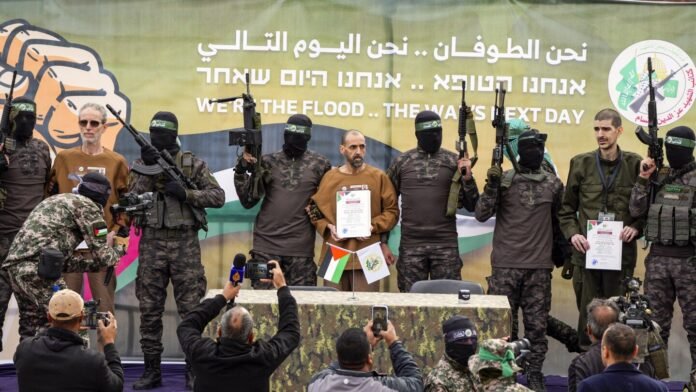Israel and Hamas conducted a fifth exchange of prisoners and hostages Saturday as part of a ceasefire agreement that has paused 16 months of war in Gaza.
Hamas released three civilian Israelis and Israel released 183 Palestinian prisoners. It was the fifth swap of hostages for prisoners since the ceasefire began on Jan. 19. Twenty-one hostages and more than 730 Palestinian prisoners have now been freed.
The civilian hostages had been abducted during the Hamas-led attack on Israel on Oct. 7, 2023, that left about 1,200 people, mostly civilians, dead and sparked the war. The prisoners released by Israel on Saturday included 111 from Gaza who were rounded up after the Hamas attack and detained without trial.
More than 47,000 Palestinians have been killed in Israel’s retaliatory war following the Hamas attack, over half of them women and children, according to Gaza’s Health Ministry, which does not say how many were militants.
Observers have been concerned that U.S. President Donald Trump’s stunning proposal to transfer the Palestinian population out of Gaza could put the fragile ceasefire deal at risk.
Here is the latest:
TEL AVIV, Israel — In their first hours as free men, the Israeli hostages released on Saturday were beginning to confront the tragic realities to which they have returned.
Eli Sharabi returned to Israel after 16 months of captivity. He was told only after his return that his wife and two daughters had been killed in the Oct. 7 militant attack, according to reports in Israeli media.
Or Levy “was not sure” what happened to his wife on that day, his mother, Geula, told Israeli media on Saturday, adding that he was not exposed to media reports while in Gaza. Levy was captured by militants from a bomb shelter near the Nova music festival in southern Israel and his wife, Einav, was killed in the attack. His mother said he also asked about Hersh Goldberg-Polin, the American-Israeli hostage who was abducted from the same bomb shelter and later killed in captivity. Levy was reunited Saturday with his 3-year-old son.
A third released hostage, Ohad Ben Ami, sat huddled with his wife and three daughters in a hospital corridor. He told them: “I have a lot of things to catch up on.” Ben Ami is a resident of Kibbutz Be’eri, one of the hardest hit communities on Oct. 7. “I need to get answers to a lot of things, and I know some of them will be difficult answers,” he said in footage released by the Prime Minister’s office. “I need to know what happened on that day.”
FA’RA CAMP, West Bank — Hundreds of Palestinians on Saturday were fleeing their homes in a refugee camp in the northern occupied West Bank as the Israeli army escalated its raid against Palestinian militants.
Israeli army bulldozers have torn up streets and alleys in Fa’ra refugee camp, a hardscrabble urban area home to over 8,000 residents, cutting off water supplies and electricity. Sewage is seeping into the rutted roads, residents say, and the conditions have become increasingly unlivable as the military destroys infrastructure and businesses.
For the past week, the Israeli army has also shut off all roads leading to and from the camp, banning cars and impeding deliveries of food and other supplies, said Asim Mansour, who runs the camp’s Popular Committee, or elected leadership.
On Saturday, residents said the Israeli army secured a passage for civilians to leave the camp. At least 1,000 residents have fled, Mansour said. Families were seen carrying their belongings and children through the mud and to the houses of their relatives in nearby villages. Mansour also said that the Israeli army had taken over 15 homes for military purposes, forcing their occupants to leave.
The Israeli military did not immediately respond to a request for comment on Saturday’s evacuations. After the ceasefire between Israel and Hamas in Gaza took effect last month, the army launched extensive raids in the northern West Bank, an escalation even from the near nightly raids that became the norm after Hamas’ Oct. 7, 2023, attack on southern Israel.

